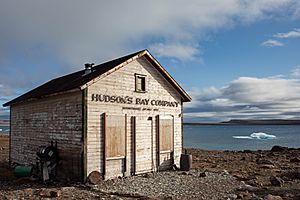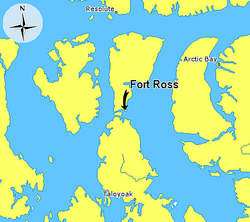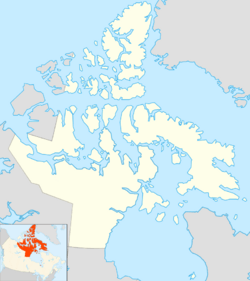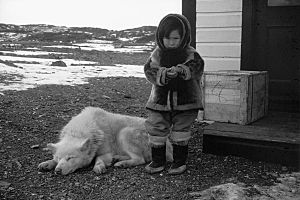Fort Ross, Nunavut facts for kids
Quick facts for kids
Fort Ross
|
|
|---|---|
|
Abandoned trading post
|
|

The post's store building in 2017
|
|

Map indicating Fort Ross, with nearby settlements shown
|
|
| Country | |
| Territory | Nunavut |
| Region | Kitikmeot |
| Established | 1937 |
| Founded by | Hudson's Bay Company |
| Named for | John Ross and James Clark Ross |
| Elevation | 5 m (16 ft) |
| Population | |
| • Total | 0 |
| Time zone | UTC-7 (MST) |
Fort Ross is a place in Nunavut, Canada, that used to be a trading post. It's on Somerset Island in the Kitikmeot Region. The Hudson's Bay Company started it in 1937. It was their very last trading post. Fort Ross only operated for eleven years. It was closed in 1948 because thick ice made it too hard to reach. This also made it too expensive to keep running.
Contents
Where is Fort Ross Located?
Fort Ross is located at the eastern end of Bellot Strait. This is on a southeastern part of Somerset Island. It sits between Hazard Inlet and Brentford Bay. The site is very close to the water, in a small area called Depot Bay. It is about 5 metres (16 ft) above sea level.
The nearest towns are quite far away. Taloyoak is about 275 km (171 mi) to the south. Resolute is 300 km (190 mi) to the north. Arctic Bay is 325 km (202 mi) to the northeast.
The Story of Fort Ross
The Hudson's Bay Company built Fort Ross in 1937. They wanted to trade furs from the island. They also hoped to make it easier for their ships to pass through the Bellot Strait. Lorenz Learmonth, the first manager, chose the exact spot. The post was named after two famous Arctic explorers, John Ross and James Clark Ross.
The trading post had four buildings. These were the manager's house, a power house, a warehouse, and a store. Workers built them in just five days in September 1937. An icebreaker ship called the SS Nascopie brought building materials and food. The ship also brought the first people to live there. This included Lorenz Learmonth and other staff. Three Inuit families from Cape Dorset also came. They built their homes near the post buildings.
In 1942, explorer Henry Larsen visited Fort Ross. He was on his way through the Northwest Passage. This was the first time someone had successfully sailed through it from west to east.
Trouble with Ice and Supplies
After 1941, the SS Nascopie tried to resupply Fort Ross in 1942 and 1943. But thick ice stopped the ship both times. In September 1943, the Nascopie had to turn back. This meant the people at Fort Ross were running out of food. They had to ration their supplies and hunt for more.
The Canadian government asked the U.S. for help. This was because Canada's planes were busy with World War II. In November, a USAAF plane was prepared for the trip. On November 4, some supplies were dropped from the air. USAAF Captain J.F Stanwell-Fletcher parachuted down. He was the first person to parachute north of the Arctic Circle. He helped prepare a landing spot for the plane. A large lake on Somerset Island was later named Stanwell-Fletcher Lake after him.
On November 7, the plane landed on a small lake about 10 miles away. It dropped off food for the Inuit people. Then, it quickly took off, taking the three staff members to safety.
Reopening and Final Closure
In 1944, the Nascopie finally reached Fort Ross again. The post was reopened with a new manager. But pack ice still made it very hard to get supplies. It also made trading difficult. Because of these problems, Fort Ross was finally abandoned in 1948. The Inuit families who lived there moved about 275 kilometres (171 mi) south. They started a new community called Spence Bay, which is now known as Taloyoak.
Fort Ross Today
Only two of the original four buildings are left. These are the post manager's house and the store. The store building was recently fixed up and made stronger. Today, Inuit caribou hunters from Taloyoak still use it as a shelter. Researchers and small boat travelers also use it as a safe place to stay.
In 2006, the CBC visited Fort Ross. Their show The National filmed there. They were traveling on the Coast Guard icebreaker Louis S. St-Laurent. This special series focused on climate change in the Arctic.
See also
 In Spanish: Fort Ross (Nunavut) para niños
In Spanish: Fort Ross (Nunavut) para niños





